Grace Elliot's Blog: 'Familiar Felines.' , page 18
April 7, 2013
Of Proper Gentlemen and Ladies - guest post by Maria Grace
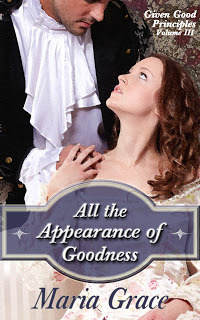 Of Proper Gentlemen and Ladies
Of Proper Gentlemen and LadiesEtiquette is an integral part of every culture. Although the details differ among regions and historical periods, the concept of correct and incorrect ways to behave remains constant. Rules of polite behavior are essential elements of communication within a society, a social code that enables individuals to understand motives and subtle messages that are otherwise too cumbersome to display through words alone.
In general these rules reflect the values of a society. Following these rules demonstrates respect for the common morality and for other people. Obedience to the guidelines of good manners also reflects on the character of the individual and suggests one is well bred and refined.
These social rules are adopted and adapted over time. Some may be written into elaborate manuals, though many are unwritten, caught rather than taught among the population at large. In periods of great social transition, like the Regency, published manuals are especially abundant.
The established etiquette in the Regency era emphasized class and rank and the proper relations between the genders. Although the rules might appear awkward and restrictive, especially for women, they did act as a safeguard against misunderstanding and embarrassment for all parties.
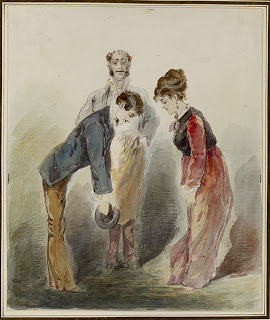 Chaperones
Chaperones Well-bred women were thought to have a "natural" sense of delicacy. Taste and poise should come naturally to a lady, and it was an indictment against their breeding to be worried about looking correct. Chaperones were one means of assisting young women in maintaining their delicacy and reputation.
Young women were protected zealously in company. Young, unmarried women were never alone in the company of a gentleman, save family and close family friends. A chaperone was also required for a young single woman to attend any social occasion. Under no circumstances could a lady call upon a gentleman alone unless consulting him on a professional or business matter.
Except for a walk to church or a park in the early morning, a lady could not walk alone. She should always be accompanied by another lady, an appropriate man, or a servant. Similarly, a proper lady did not ride abroad by herself. Whether horseback or in a carriage, she should bring an appropriate companion to protect her reputation.
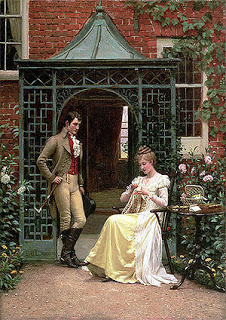 Introductions
Introductions It was unacceptable to speak to anyone of good breeding without a formal introduction by a third party. The higher ranking individual (or the woman in the case of two equally ranking individuals) indicates whether he or she wishes to permit the introduction of an inferior. In the case he or she desired an introduction a third party would be asked to make one. At a public ball, the Master of Ceremonies would conduct this service to enable gentleman and ladies to dance. However, if the higher ranking person did not desire an introduction, one could not be forced upon them.
In some circumstances, the higher ranking person could introduce him or herself to the lower one. When introduced, the person of lower rank bowed or curtsied. Gentlemen and ladies of equal rank bowed and curtsied when formally introduced to each other and again when parting.
Touching and tipping one's hat, using the hand farthest away from the lady to raise it, was a standard salutation. Not returning it would be very rude. After being introduced, individuals always acknowledged each other in public, at minimum with a tip or touch to the hat or a slight bow of the shoulders.
If a gentleman met a lady with whom he had a friendship and who signified that she wished to talk, good manners dictated he should turn and walk with her as they conversed. It was not appropriate to make a lady stand talking in the street.
Failure to acknowledge an acquaintance was a breach in conduct and considered a cut. Manuals warned that a lady should never ‘cut’ someone unless ‘absolutely necessary’ and only ladies were truly justified in delivering a ‘cut’.
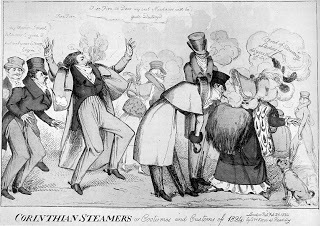 Conversation
ConversationThe heart of polite sociability was conversation. The whole purpose of conversation was to please other people and to be deemed pleasing. In general, conversation was tightly controlled by rules of etiquette as well. The list of unacceptable topics far outnumbered the acceptable ones.
A polite individual did not ask direct personal questions of someone they had just met. To question or even compliment anyone else on the details of their dress might also be regarded as impertinent. Personal remarks, however flattering, were not considered good manners. Etiquette manuals counseled such comments should be exchanged only with close family and intimate friends.
Similarly, scandal and gossip should be omitted from public conversation. Any references to pregnancy, childbirth, or other natural bodily functions were considered coarse and carefully sidestepped. A man could sometimes discuss his hunters or driving horses in the presence of ladies though it was generally discouraged. Greater latitudes of conversation were allowed when the genders were segregated, particularly for the men.
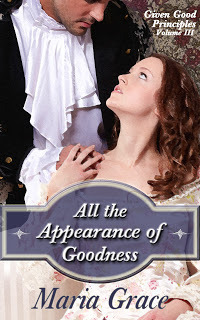 For the Gentleman
For the Gentleman While enjoying the company of ladies, a gentleman was under an obligation to please the women, extending to a lady of equal rank that respect usually due to a social superior.
If walking with a lady and a flight of stairs was encountered. Ascending the stairs, he should precede the lady (running, according to one authority); in descending, he followed.
In a carriage, a gentleman took the seat rear facing. If he for some reason, he found himself alone in a carriage with a lady, he could not sit next to her unless he was her husband, brother, father, or son. A proper gentleman always exited a carriage first so that he may hand the lady down, always taking appropriate care not to step on her dress.
If a gentleman attended a public exhibition or concert in the company of a lady, he would go in first in order to find her a seat, making sure to remove his hat. If in military uniform, a gentleman never wore a sword in the presence of ladies, nor did he smoke in their presence, though the use of snuff was acceptable.
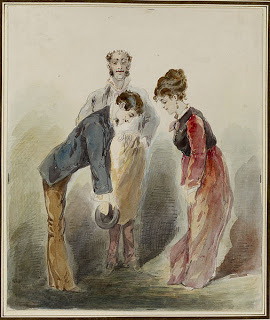 Touch
TouchNot surprisingly, good manners required all forms of touching between members of the opposite sex were to be kept to a minimum. Putting a lady's shawl about her shoulders, or assisting her to mount a horse, enter a carriage and for a gentleman to take a lady's arm through his to support her while out walking were considered acceptable of courtesy.
Shaking hands, though, was not. In the Regency era, shaking hands was considered a mark of unusual affability or intimacy. Only gentlemen of about the same social class, who knew each other well, shook hands. Moreover, the intimacy of shaking hands was a mark of condescension, if offered by one of a higher rank.
Shaking hands with a person of the opposite sex was less frequent and less proper. A touch, a pressure of the hands, was the only external signs a woman could give of harboring a particular regard for certain gentleman and was not to be thrown away lightly.Between sisters or ladies of equal age or rank a kiss on the cheek was acceptable. A gentleman might kiss a lady's hand, but kissing it 'passionately' was a gesture of excessive intimacy.
References
A Lady of Distinction - Regency Etiquette, the Mirror of Graces (1811). R.L. Shep Publications (1997)Black, Maggie & Le Faye, Deirdre - The Jane Austen Cookbook. Chicago Review Press (1995) Byrne, Paula - Contrib. to Jane Austen in Context. Cambridge University Press (2005)Day, Malcom - Voices from the World of Jane Austen. David & Charles (2006)Downing, Sarah Jane - Fashion in the Time of Jane Austen. Shire Publications (2010)Jones, Hazel - Jane Austen & Marriage . Continuum Books (2009)Lane, Maggie - Jane Austen's World. Carlton Books (2005)Lane, Maggie - Jane Austen and Food. Hambledon (1995)Laudermilk, Sharon & Hamlin, Teresa L. - The Regency Companion. Garland Publishing (1989)Le Faye, Deirdre - Jane Austen: The World of Her Novels. Harry N. Abrams (2002)Ray, Joan Klingel - Jane Austen for Dummies. Wiley Publishing, Inc. (2006)Ross, Josephine - Jane Austen's Guide to Good Manners. Bloomsbury USA (2006)Selwyn, David - Jane Austen & Leisure. The Hambledon Press (1999)Trusler, John - The Honours of the Table or Rules for Behavior During Meals. Literary-Press (1791)Vickery, Amanda - The Gentleman's Daughter. Yale University Press (1998)
 Author Maria Grace Author bio
Author Maria Grace Author bioThough Maria Grace has been writing fiction since she was ten years old, those early efforts happily reside in a file drawer and are unlikely to see the light of day again, for which many are grateful.
She has one husband, two graduate degrees and two black belts, three sons, four undergraduate majors, five nieces, six cats, seven Regency-era fiction projects and notes for eight more writing projects in progress. To round out the list, she cooks for nine in order to accommodate the growing boys and usually makes ten meals at a time so she only cooks twice a month.
She can be contacted at:
email: author.MariaGrace@gmail.com.
Facebook: facebook.com/AuthorMariaGraceOn Amazon.com: amazon.com/author/mariagraceVisit her website Random Bits of Fascination (AuthorMariaGrace.com)On Twitter @WriteMariaGraceOn Pinterest : http://pinterest.com/mariagrace423/English Historical Fiction Authors (EnglshHistoryAuthors.blogspot.com)Austen Authors (AustenAuthors.net)
Published on April 07, 2013 04:24
April 2, 2013
Superstitions: Ladders and Mirrors
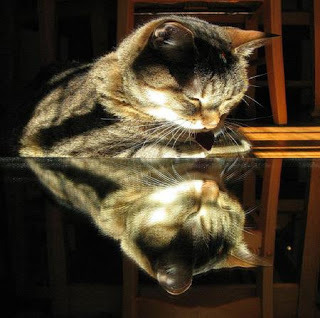 Have you ever wondered where the superstitions concerning bad luck and ladders, and broken mirrors, came from? Well, as I'm on vacation this short post in inspired by one of my holiday reads (Black Cats and Evil Eyes by Chloe Rhodes).
Have you ever wondered where the superstitions concerning bad luck and ladders, and broken mirrors, came from? Well, as I'm on vacation this short post in inspired by one of my holiday reads (Black Cats and Evil Eyes by Chloe Rhodes). Not Walking Under LaddersIt seems common sense not to walk under a ladder, especially if a painter is balancing a pot of paint at the top - but would you believe this superstition actually goes back to the early church!
 The Ladder of Divine AscentWhen a ladder leans against a wall it forms a triangular shape with the ground. The triangle is held to have sacred properties as it represents the Trinity: God, the Son and the Holy Spirit. To walk under a ladder would break the triangle and thus be irreverent to the Trinity - and by extension sinful.
The Ladder of Divine AscentWhen a ladder leans against a wall it forms a triangular shape with the ground. The triangle is held to have sacred properties as it represents the Trinity: God, the Son and the Holy Spirit. To walk under a ladder would break the triangle and thus be irreverent to the Trinity - and by extension sinful. 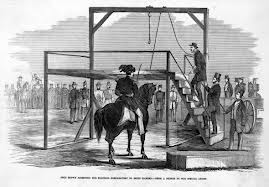 The soul of the condemned man was said to
The soul of the condemned man was said to linger beneath the ladder.Another explanation, also involving the soul, was associated with death by hanging. The condemned man would climb a ladder up onto the scaffold. When he had been executed his soul, since it was unfit for heaven, lingered beneath the ladder. Hence, to walk beneath the ladder was to mingle with the souls of the undead.
Breaking a Mirror - 7 Years Bad Luck
Superstitions linking bad luck to a broken mirror go back to the Romans and other ancient civilisations. This is largely to do wit the belief that looking at a reflected image meant part of the soul was housed within the mirror. Hence, if the mirror was broken then the soul would also be damaged.
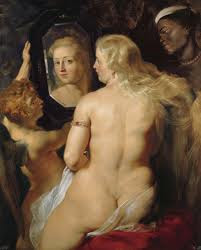 The reflected image captures
The reflected image captures part of the soulThe first written reference to 7 years bad luck was in 1851. This very specific length of time may well be related to the Roman belief that the body renewed itself every 7 years and so hopefully all previous damage would be healed.
Obviously the fear of broken mirrors runs deep because it was mention in John Brand's 18th century publication, Observation on the Popular Antiquities of Great Britain, where he wrote:"The breaking a Looking Glass is accounted a very unlucky accident. Mirrors were formerly used by magicians in their superstitious and diabolical operations."
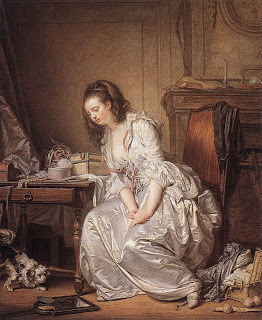 The Broken Mirror
The Broken MirrorJean Baptiste GreuseAlso, Alfred, Lord Tennyson in 1842 made a famous mention of mirrors in, The Lady of Shallot'.The mirror cracked from side to side,'The curse has come upon me' said the Lady of Shallot.
Oh well, after all this bad luck, I'd better toss some salt over my shoulder (or does that also bring bad, no good, luck…ho hum)
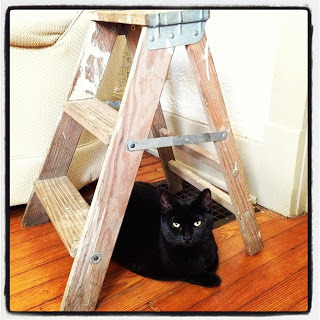 Superstitious? Me?
Superstitious? Me?I'm a black cat - I laugh in the face of superstition.
Published on April 02, 2013 12:53
March 26, 2013
Tower of London: Raven Mad
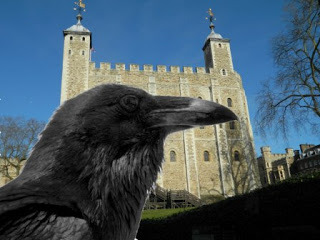
England's most famous ravens are those that live at the Tower of London. Legend has it that if the six resident birds left the Tower then the kingdom would crumble and fall into the waves. It seems King Charles II decided to take chance out of the equation by protecting the Tower's ravens and encouraged them to stay. The story goes that the royal astronomer, John Flamstead, was less that thrilled by the monarch's decision, complaining that the birds got in the way of his observations in the White Tower.
In the modern day seven ravens (one birds is a spare!) are looked after the Ravenmaster. Their wings are clipped so they cannot fly away but despite this, occaisionally one goes AWOL or is sacked. A raven called Grog diseappeared, last seen outside an East End pub, whilst another called George was dismissed for chewing television aerials.
 Odin, with Huginn and Muninn on his shoulders.But ravens have been associated with mythology and legend for at least a millennia before the first stone of the Tower of London was laid down. In Norse Mythology, a pair of ravens, Huginn and Muninn, were the familiars of the Norse god, Odin. It was their job to fly out at dawn, collecting gossip from around the world and return to their master at dusk. A poem compiled in the 13th century, from earlier sources, tells of Odin's affection for the birds:
Odin, with Huginn and Muninn on his shoulders.But ravens have been associated with mythology and legend for at least a millennia before the first stone of the Tower of London was laid down. In Norse Mythology, a pair of ravens, Huginn and Muninn, were the familiars of the Norse god, Odin. It was their job to fly out at dawn, collecting gossip from around the world and return to their master at dusk. A poem compiled in the 13th century, from earlier sources, tells of Odin's affection for the birds: Huginn and Muninn fly each dayover the spacious earth.I fear for Huginn, that he come not back,yet more anxious am I for Muninn
 Another image of Odin, with Huginn and MuninnIn England, medieval folk lore linked the appearance of a raven to predicting an impending death. It was said that a bird perched on a house of a sick person was sure sign they would not recover. It's possible this reputation came about because ravens eat carrion and therefore have a reputation for sniffing out death - an impression heightened when farmers report having seen ravens hovering near injured sheep, waiting for them to die so they can feast.
Another image of Odin, with Huginn and MuninnIn England, medieval folk lore linked the appearance of a raven to predicting an impending death. It was said that a bird perched on a house of a sick person was sure sign they would not recover. It's possible this reputation came about because ravens eat carrion and therefore have a reputation for sniffing out death - an impression heightened when farmers report having seen ravens hovering near injured sheep, waiting for them to die so they can feast.
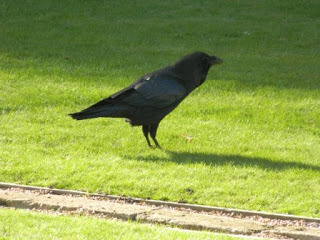 One of the ravens currently resident at the Tower
One of the ravens currently resident at the TowerMarch 2013Perhaps it is their sinister cawing, or the jet black nature of their plumage, but from Virgil writing in 40BC, to Pliny the Elder in AD 77, and indeed William Shakespeare in the early 17th century (Macbeth) - ravens are regarded as prophetic or agents of death.
"The raven himselfe is hourseThat croaks the fatall entrance of DuncanUnder my battlements."
But if you think yourself immune to such superstition, who has not heard this rhyme about magpies ?(a member of the corvid family and a relative of the raven): One for sorrow,
Two for joy, Three for a girlAnd four for a boy."
 An Australian magpie pursuing a cyclist.It seems the magpie is beleaguered so because, according to Christian folklore, the magpie was the only bird to remain silent and not sing to comfort Jesus at his crucifixion. Perhaps even more sinister is Scottish ore that holds a magpie keeps a drop of the devil's blood beneath his tongue!
An Australian magpie pursuing a cyclist.It seems the magpie is beleaguered so because, according to Christian folklore, the magpie was the only bird to remain silent and not sing to comfort Jesus at his crucifixion. Perhaps even more sinister is Scottish ore that holds a magpie keeps a drop of the devil's blood beneath his tongue!So if you meet that most portentous of sights, a lone magpie, how can you diffuse it's evil influence? Simple! You talk to him, saying:
"Morning, Mr Magpie, and how is your wife?"
Hence invoking the presence of a second bird and converting sorrow to joy!
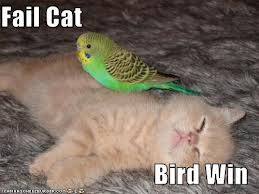
Published on March 26, 2013 08:30
March 20, 2013
London Then and Now: Hogarth's House
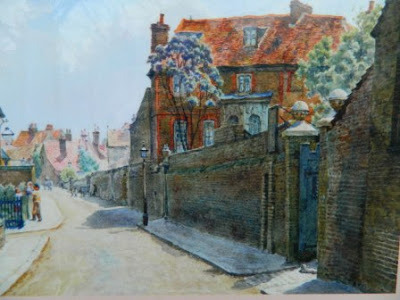 Hogarth's House - the red-brick building behind the garden wall.
Hogarth's House - the red-brick building behind the garden wall.Note the narrow country lane running outside the perimeter.
I don't remember how my fascination with the Georgian artist, William Hogarth began - but last weekend it led me to visit his house in Chiswick. This turned out to be a bitter - sweet experience. On the plus side, the house has been beautifully restored and is FREE to enter - on the minus side, the area around the house has become perhaps one of the most dirty, depressing areas of London, complete with an arterial dual-carriageway right outside the garden wall.
 Here I am (March 2013) with my back against the same wall
Here I am (March 2013) with my back against the same wallshown in the painting above.
Sad - isn't it?
Hogarth was very much a creature of London and used his observation of the city characters to fuel his art. However, in the early 18th century the capital was a very unpleasant place in the summer heat and to escape the stink and risk of disease, Hogarth bought a house in rural Chiswick (see the print below the next photograph to see how the area looked in his day.)
 The house as it is today
The house as it is today(As close as I could get to the top picture - without getting run over!)
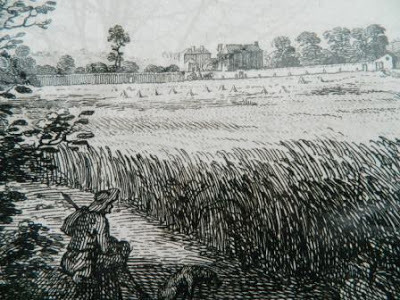 The house as Hogarth would have seen it in the early 18th century
The house as Hogarth would have seen it in the early 18th century looking across Chiswick Common Field
The house was built between 1713 and 1715 in what was then a walled orchard. The Hogarth family used it from 1749.
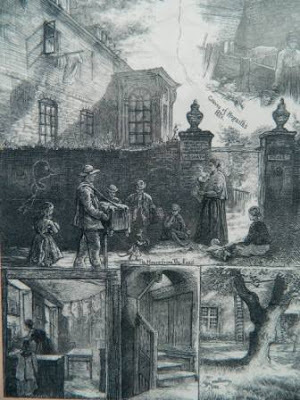 Images of the house circa the 19th century
Images of the house circa the 19th centuryIn Victorian times the house was lived in by the Clacks and the Coles. The Coles were market gardeners, whilst it was recorded that Mrs Clack kept pigs in the garden and ran a shop in her living room. In 1890 a gentleman called Alfred Dawson restored the house and let it to a nurseryman, John Allgrove.
 This mulberry tree is centuries old -
This mulberry tree is centuries old - Growing in the garden of Hogarth's House
(Annexe in the background)
This plot of land was enclosed in 1670 to form a walled garden and it was planted with a variety of fruit trees. It seems likely that the Downes family planted the mulberry tree (above) in the late 17th century - and it is still thriving to this day. The photo below shows Mr Allgrove and his wife Elizabeth, in the 1890's, standing beside the mulberry tree in front of the house.
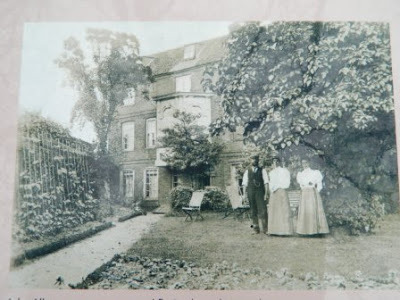 Standing in front of the mulberry tree are the Victorian inhabitants of the house;
Standing in front of the mulberry tree are the Victorian inhabitants of the house;Mr Allgrove, his wife Elizabeth, and another lady.
 The house was damaged in WWII by a parachute bomb.
The house was damaged in WWII by a parachute bomb. The house was badly damaged in 1940 by a parachute mine and remained semi-derelict and boarded up until the 1950's, when Middlesex County Council repaired the house and opened it to the public. After a more recent refurbishment, it was opened again as a museum in November 2011 (by the comedian Dara O'Briain - I have no idea what connection he has to Hogarth but I'd love to know!)
 A travesty!
A travesty! If you're going to name a building after Hogarth-
make sure its worthy of his name. And finally, if you are going to use someone's name - at least do them the decency of making the building worthy of it!
Published on March 20, 2013 02:28
March 13, 2013
Unofficial London: Gin Lane

As an avid reader of historical romance novels, one of my favourite authors is Elizabeth Hoyt and her 'Maiden Lane' books. Set in the Georgian period the series is based around an orphanage in the notorious St Giles district of London. This was a district known for its squalor and poverty, a place where criminals thrived and gin-selling flourished. The Georgian artist William Hogarth created 'Gin Lane' as a piece of social comment on the squalor and lawlessness of St Giles, and after reading Ms Hoyt's books, I looked at the etching with fresh eyes.
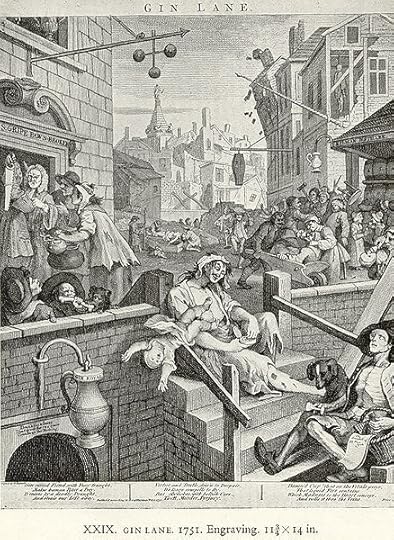
The focal point of the picture is the half-naked woman in the foreground. In a drunken stupor she is careless of her baby, who falls from her arms into the cellar of the neighbouring gin shop (note the jug-shaped shop sign - to alert those who couldn't read as to where they could purchase alcohol) The woman is shown with sores on her legs, probably syphilitic ulcers, the implication being that she is a prostitute.
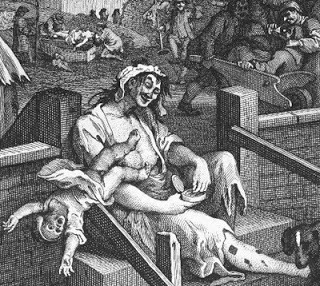
Sadly, this scene is not as outlandish as it might appear. Records exist of a woman, Judith Dufour, who reclaimed her child from the workhouse and then strangled it, in order to sell the child's clothes (for 1s. 4d.) in order to buy more gin.
In Hogarth's painting, languishing in front of the disreputable mother is a skeletal pamphlet-seller. He rests with his eyes closed, glass in hand (from which he drank gin?) whilst a leaflet titled "The Downfall of Mrs Gin," moralising about the evils of alcohol, spills from his basket.
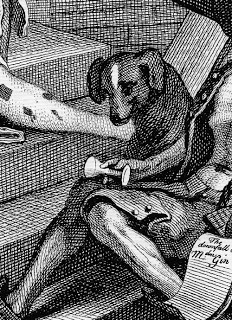
To the left of the picture is Mr Gripe's pawnbrokers shop. He is buying a carpenter's tools and a housewife her cooking pots, supplying them with money to buy their next drink.
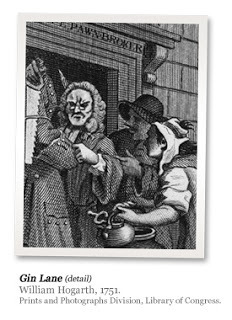 If you look carefully, in the top right hand corner of the painting is a barber, who has hung himself because no one has the money for a shave. Apart from gin-sellers and pawnbrokers, the only other business to survive is the undertaker (again, note the coffin-shop sign) kept busy by gin-related deaths.
If you look carefully, in the top right hand corner of the painting is a barber, who has hung himself because no one has the money for a shave. Apart from gin-sellers and pawnbrokers, the only other business to survive is the undertaker (again, note the coffin-shop sign) kept busy by gin-related deaths. 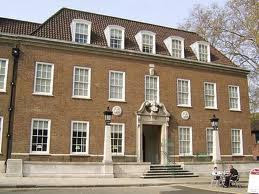 The Foundling Hospital, as it is today - a museum.Intriguingly, the artist Hogarth worked with a philanthropist called Thomas Coram who established the Foundling Hospitalin London. Going back to Ms Hoyt's 'Maiden Lane' books, these also feature a charitable orphanage and this link made me wonder if original the inspiration behind Ms Hoyt's Maiden Lane series, came from seeing Hogarth's work and reading his support for orphans and foundlings.
The Foundling Hospital, as it is today - a museum.Intriguingly, the artist Hogarth worked with a philanthropist called Thomas Coram who established the Foundling Hospitalin London. Going back to Ms Hoyt's 'Maiden Lane' books, these also feature a charitable orphanage and this link made me wonder if original the inspiration behind Ms Hoyt's Maiden Lane series, came from seeing Hogarth's work and reading his support for orphans and foundlings. Have any of you read the Maiden Lane books? Which is your favourite?
Published on March 13, 2013 02:47
March 6, 2013
Unofficial London: In Search of Almack's

In Georgian and Regency England, if you were an aspiring socialite then Almack's was the place to be seen. It was there that select ladies might dance with the most eligible bachelors in England, and to be admitted implied you were a member of the coveted social elite. It could be argued Almack's was a triumph of marketing over content; the food was stodgy, the drink ( non-alcholic) was nothing special and yet it was the pinnacle of aspiration for a young lady on the hunt for a husband.
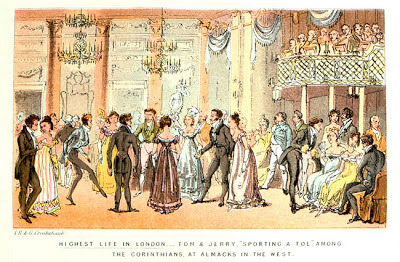 A ball at Almack's.Balls were held once a week during the season, on a Wednesday evening, and entry was via a voucher purchased for the season at a cost of ten guineas. However, it was not cost but the difficulty of obtaining a voucher that was the challenge. The idea of the Almack's patronesses was to make good-breeding and social standing the criteria for entry and hence keep out the undesirable nouveau riche. But not even being a member of the nobility guaranteed acceptance, for only about three-quarters ever gained vouchers.
A ball at Almack's.Balls were held once a week during the season, on a Wednesday evening, and entry was via a voucher purchased for the season at a cost of ten guineas. However, it was not cost but the difficulty of obtaining a voucher that was the challenge. The idea of the Almack's patronesses was to make good-breeding and social standing the criteria for entry and hence keep out the undesirable nouveau riche. But not even being a member of the nobility guaranteed acceptance, for only about three-quarters ever gained vouchers. 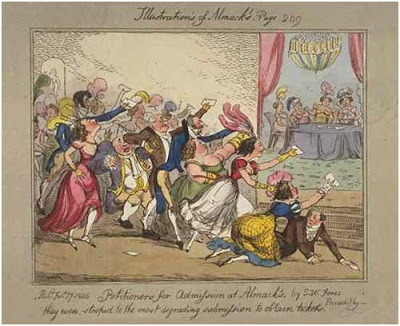 Petitioners vying to get to attract the attention of Almack's
Petitioners vying to get to attract the attention of Almack'slady patronesses.
In order for your name to be put on the list you must be approved by one of six or seven 'patronesses' - all high-born ladies, of whom Lady Jersey was in command. Even once your name was placed on the hallowed list of two thousand members, you could still be excluded if your behaviour fell below that expected. These seven autocrats met each Monday evening between April and August to discuss those members whose poor behaviour may cause them to be barred. Indeed the Duke of Wellington was once refused entry for being too late (last entry at 11 pm and he arrived at 11.07 pm) and wearing trousers instead of the regulation knee-breeches and silk stockings.
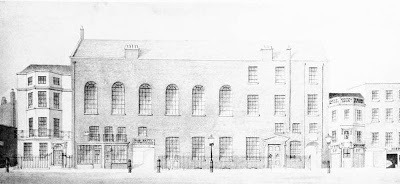 Almack's Assembly Rooms in the 18th century. If once to Almack's you belong,
Almack's Assembly Rooms in the 18th century. If once to Almack's you belong,Like monarchds, you can do no wrong;But banished thence on Wednesday night, By Jove, you can do nothing right. Henry Luttrell
 Where the original Alamck's once stood...So what remains of Almack's to this day? On a recent trip into London I visited Kings Street in search of the once famous building. What I found was a glass and steel edifice bearing a once illustrious name. Being a romantic, I wonder if on a very quiet night, when all the lights are off and there is no traffic, you can still here the echoes of the orchestra playing a cotillion...
Where the original Alamck's once stood...So what remains of Almack's to this day? On a recent trip into London I visited Kings Street in search of the once famous building. What I found was a glass and steel edifice bearing a once illustrious name. Being a romantic, I wonder if on a very quiet night, when all the lights are off and there is no traffic, you can still here the echoes of the orchestra playing a cotillion... 
Published on March 06, 2013 01:08
February 27, 2013
Eye-catching Oscar Fashion - Regency Style!
 Even Anne Hathaway's gown appeared on a
Even Anne Hathaway's gown appeared on a 'worst' dress list!
Photo courtesy of Disney ABC Photostream.Debate about which were the best and worst gowns at the Oscars is rife on the internet; the strange thing is that I saw the several dresses appear on both lists: best and worst! I thought Helena Bonham-Carter's black dress with white gauzy underskirt was beautiful and suited her quirky character perfectly…and yet it appeared on a 'worst' dress list. Bah!
All of which set me wondering about what the regency woman would have worn to attract attention and impress. In the late 18th and early 19th centuries, young women took the business of attending a dance very seriously because it was a major opportunity to snare a husband.
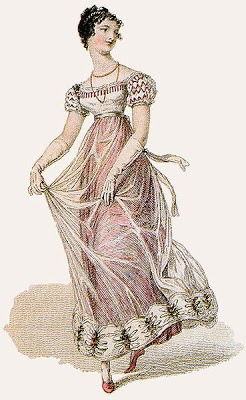 A wonderful, diaphenous Regency gown.
A wonderful, diaphenous Regency gown.At a ball, a man was not obliged to dance but could watch from the sidelines to study the feminine charms parading around him. Amidst the elegant gowns, coiffured hair and graceful dancing, if a woman was to stand out and tempt her reluctant 'Mr Darcy' she had to look her absolute stunning best. Regency dresses must have been exquisite. Delicate, flimsy fabrics such as muslin or crepe de Chine were all the rage. Waistlines were high and necklines low, indeed doctors blamed the rise of consumption on insufficient clothing and exposing the chest, they called it 'muslin disease'. Although no prude, apparently Jane Austen drew the line at having too much shoulder on show and disapproved of "ugly naked shoulders." A popular colour for that first ball gown was white, although light colours such as pink, yellow, pale blue or green, were also good choices.
 Best or worst?
Best or worst?Photo courtesy of Disney ABC Photostream.
"As a lady's quality …was once determined by the circumference of her hoop… [Is] now measured by the length of her tail." Miss Bingley, Pride and Prejudice. Around 1800 it became fashionable for a dress to have a train, to avoid tripping the wearer whilst dancing the train was elevated with the aid of a small hoop or similar device, and let down again afterwards. Shoes were often made to match the dress and had silk soles, and were tied on with ribbons round the ankle a bit like a modern ballerina's pump. The shoe might be adorned with a 'shoe-rose', which was a rosette of ribbon attached near the toe. The best stockings were made of silk, and usually white or pink, and have clocks (embroidery) inserts. The stocking came just above the knee and were held in place with a ribbon garter although in the late 18th century a spring-garter (presumably an early form of elastic) was invented and proved very popular.
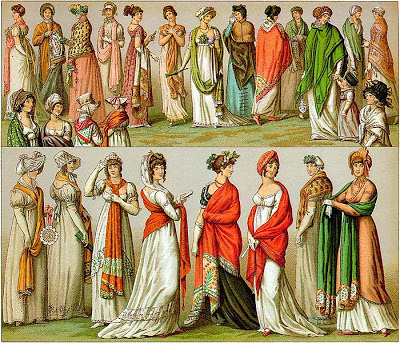 When wearing a flimsy gown, a shawl was a vital accessory.
When wearing a flimsy gown, a shawl was a vital accessory. Gloves were de rigour at a ball; usually white, but again pastel shades of lemon or lilac were acceptable and ingenious devices existed to keep elbow length gloves unwrinkled whilst dancing.
Hair would be carefully dressed and curled, and often adorned with tall feathers. Not only did an ostrich feather make the wearer appear taller and indicated wealth (they were expensive) but they also bobbed in time to the dance, emphasising the dancer's grace and deportment.
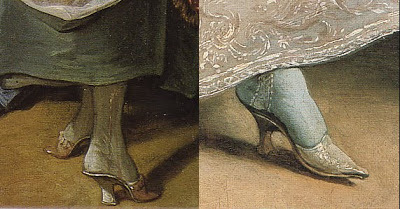 Ballrooms were often hot and stuffy so a fan was a vital accessory. Apart from cooling the owner, it could be used for flirtation, to signal in code, or even have an aide-memoire written on it for those tricky dance steps. It is salient to remember that once a beau had snared a bride, as a husband he would be more likely to notice the cost of a gown, than its cut! This takes me back to the Oscars. Who did you think was best dressed? Which gowns were your favourites, and which wouldn't you be seen dead in? Do leave a comment.
Ballrooms were often hot and stuffy so a fan was a vital accessory. Apart from cooling the owner, it could be used for flirtation, to signal in code, or even have an aide-memoire written on it for those tricky dance steps. It is salient to remember that once a beau had snared a bride, as a husband he would be more likely to notice the cost of a gown, than its cut! This takes me back to the Oscars. Who did you think was best dressed? Which gowns were your favourites, and which wouldn't you be seen dead in? Do leave a comment. 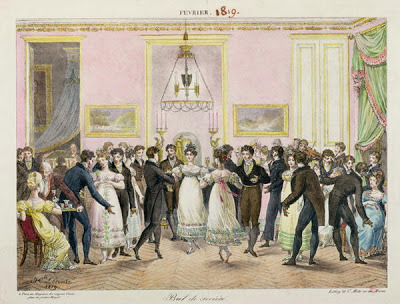 A Society Ball in 1819.
A Society Ball in 1819.
Published on February 27, 2013 01:15
February 20, 2013
Tower of London: Polar Bears in the Thames
In this the third post about animals at the Tower of London, we look at bears - or polar bears to be precise.
 One of the sculptures (made from chicken wire) at the Tower of LondonIn 1252 King Henry III (1207 - 72) was given a Norwegian bear by King Hakon V. This bear was described as "pale" , which is significant because the black bear (albeit sometimes light coloured) was common in England at the time. It seems likely that this bear was significantly different in order to merit it being a gift, and was probably a polar bear.
One of the sculptures (made from chicken wire) at the Tower of LondonIn 1252 King Henry III (1207 - 72) was given a Norwegian bear by King Hakon V. This bear was described as "pale" , which is significant because the black bear (albeit sometimes light coloured) was common in England at the time. It seems likely that this bear was significantly different in order to merit it being a gift, and was probably a polar bear. The bear arrived with a keeper, and once again the Sheriffs of the City of Londonwere asked [told] to pay for the animals upkeep. The Sheriffs allotted around tuppence a day, which considering the prevalent poverty of the day, must have seemed galling to some. However, after a year, the sheriffs decided it was time the bear caught it's own food in the Thames; at that time the Thameswas a clean river, rich with salmon and fish."fat and sweet salmon [are] dailie taken."
 The White Tower at the Tower of LondonThe bear was fitted with a chain and muzzle, and the keeper expected to take the beast down to the river to fish and bathe. The sheriffs thoughtfully provided the keeper with a thick cape, presumably to keep out the cold on the riverbank.
The White Tower at the Tower of LondonThe bear was fitted with a chain and muzzle, and the keeper expected to take the beast down to the river to fish and bathe. The sheriffs thoughtfully provided the keeper with a thick cape, presumably to keep out the cold on the riverbank."Greetings. We [the King]command you that for the keeper of our white bear , recently arrived from Norway… ye cause to be had one muzzle and one iron chain to hold the bear without the water, one long strong cord, to hold the same bear fishing or washing himself in the Thames."
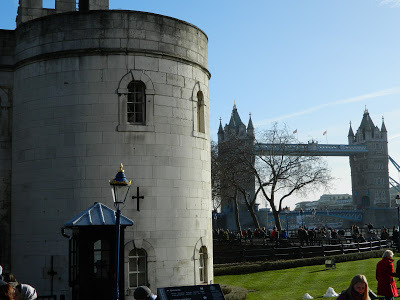 The Tower of London with Tower Bridge (over the Thames)
The Tower of London with Tower Bridge (over the Thames) in the background.King Edward I (Henry III's son) took an interest in his father's menagerie. He employed 4 keepers, each paid 3d each a day, plus a 10d allowance towards animal food. Some thirty years after the original bear, records exist of payment for a white bear called Lynn (she originated from a place of the same name) being transported by boat (presumably up the Thames) to the Tower.
A few centuries later, it seems curiosity was superseded by cruelty. King James I of England (1603-25) made the bears, lions and dogs fight each other. To this end he had a platform built from which he could watch the so-called 'sport'. This was a vicious activity where the bears were often chained and toothless, and had massive mastiff dogs set on them. The 'sport' was in betting on which animal would inflict the most damage.
 And finally, did you know that most polar bears are Capricorns - since the majority are born between late December and mid January.
And finally, did you know that most polar bears are Capricorns - since the majority are born between late December and mid January.
Published on February 20, 2013 02:23
February 17, 2013
Welcome! Arlene Webb - author
Today I'm delighted to welcome author, Arlene Webb, to the blog. I love the premise behind Arlene's latest "Prepper" series (people who are prepared for anything...but read on to find out more.)
 Be PreparedTrying to be ready, so as to survive with minimal screw-ups, has to be a good thing in a world where natural and man-made disasters happen anywhere and everywhere.When I was asked to write a story with ties to Preppers (survivalists who prepare for whatever life can throw at them), I was intrigued at how much fun it could be to write about the obvious, unexpectedly falling in love, that blindsides people who think they have a handle on everything.My heroine in Falling for Water has a touch of OCD disorder, while the hero doesn’t easily recover from loss, so much so that he charms everyone and falls for no one. When the two are thrown together and bullets fly, compulsion and closed heart are pushed back into the past while the need for the other to survive takes over
Be PreparedTrying to be ready, so as to survive with minimal screw-ups, has to be a good thing in a world where natural and man-made disasters happen anywhere and everywhere.When I was asked to write a story with ties to Preppers (survivalists who prepare for whatever life can throw at them), I was intrigued at how much fun it could be to write about the obvious, unexpectedly falling in love, that blindsides people who think they have a handle on everything.My heroine in Falling for Water has a touch of OCD disorder, while the hero doesn’t easily recover from loss, so much so that he charms everyone and falls for no one. When the two are thrown together and bullets fly, compulsion and closed heart are pushed back into the past while the need for the other to survive takes over
Falling for Water - the blurb
Water.
What Cassi thought was a simple obsession with clean water has taken over her life. When she orders a distiller online to replace the one smashed by her abusive boyfriend, she gets more than she bargained for.
Enter a man with a badge, hunting a terrorist, and Cassi is his number one suspect. Not only is she struggling with her fixation on pure H2O, she has to prove she’s not the one he’s looking for—only she kind of wishes she was. Before she knows it, Cassi is in over her head.
Justice
Ray had everything, until a random crime ends badly and he’s left to hold to his grief or make changes in his life. Charming his way into people’s personal business—slapping on the cuffs as needed—gives him reason to get up in the morning. When he falls headfirst into another chance at love, he must take the plunge without hesitation or risk losing more than his heart.
As the pair join hands, sparks fly as well as bullets, leaving Cassi and Ray to wonder if the universe could right itself. Will the past reach out and drown their chance for happiness? EXCERPT He stared at her, his expression wary. “And I’m thrilled you’re so into evolution, variation, and moving toward different things. I…er…just wondered, do you have a problem with saliva?”“Saliva? What the hell are you talking about?”He smiled. Not slow and lazy, not sweet and gentle, but the wolf smile she’d seen at the bar. “You admitted a thing with water right away. So what I’m hearing is no, I love saliva. Go ahead and slap me, and…maybe I’ll stop.” He grabbed her, yanked her up, and took her lips with his.Ray tried for gentle and slow, but the moment his lips locked onto hers it felt like he had to make this the kiss of a lifetime or she’d slip through his fingers and disappear. She’d either run screaming from yet another bully who took advantage of a vulnerable state, or she’d fall through the cracks of the justice system and out of his reach.From his mouth to hers, he yearned to dive in fast and hard, plundering with his tongue until she opened more than her heart to him by confiding an intense trauma. He wanted the supple and beautiful body rolled over him as well.He deepened the kiss, and his heartbeat pounded faster and faster as the tension left her shoulders. She melted into him, soft and sweetly yielding to his aggressive hardness, and she began kissing him back.His careful exploration, the tip of tongue easing along the seams of her mouth, forced his lust into an easy, steady climb as lips meshed, escalating on the roller coaster scale to maybe a five, a first-time kiss like when a boy walks a girl to her door.Forget that. It was no-hold-back time. He was too into the taste and feel of this woman to strive for less, and he had to bring her over the edge with him. Plunge down and down into the world-is-about-to-end type kiss. A kiss that’d stay with her, marking her as his own.
Falling for Water is available at Decadent Publishing. http://www.decadentpublishing.com/product_info.php?manufacturers_id=134&products_id=701&osCsid=6c1232251c1e45744bd0b3ee7262f414
Amazon: http://www.amazon.com/Falling-Water-Prepper-Romance-ebook/dp/B00AV2FM2I
Nook: http://www.barnesandnoble.com/w/falling-for-water-arlene-webb/1114050348 For more information about Decadent Publishing authors, books, and their submissions guidelines, visit www.decadentpublishing.com .
Decadent Publishing is current accepting submissions in all sub-genres of romance, including their ongoing series'.
 Be PreparedTrying to be ready, so as to survive with minimal screw-ups, has to be a good thing in a world where natural and man-made disasters happen anywhere and everywhere.When I was asked to write a story with ties to Preppers (survivalists who prepare for whatever life can throw at them), I was intrigued at how much fun it could be to write about the obvious, unexpectedly falling in love, that blindsides people who think they have a handle on everything.My heroine in Falling for Water has a touch of OCD disorder, while the hero doesn’t easily recover from loss, so much so that he charms everyone and falls for no one. When the two are thrown together and bullets fly, compulsion and closed heart are pushed back into the past while the need for the other to survive takes over
Be PreparedTrying to be ready, so as to survive with minimal screw-ups, has to be a good thing in a world where natural and man-made disasters happen anywhere and everywhere.When I was asked to write a story with ties to Preppers (survivalists who prepare for whatever life can throw at them), I was intrigued at how much fun it could be to write about the obvious, unexpectedly falling in love, that blindsides people who think they have a handle on everything.My heroine in Falling for Water has a touch of OCD disorder, while the hero doesn’t easily recover from loss, so much so that he charms everyone and falls for no one. When the two are thrown together and bullets fly, compulsion and closed heart are pushed back into the past while the need for the other to survive takes overFalling for Water - the blurb
Water.
What Cassi thought was a simple obsession with clean water has taken over her life. When she orders a distiller online to replace the one smashed by her abusive boyfriend, she gets more than she bargained for.
Enter a man with a badge, hunting a terrorist, and Cassi is his number one suspect. Not only is she struggling with her fixation on pure H2O, she has to prove she’s not the one he’s looking for—only she kind of wishes she was. Before she knows it, Cassi is in over her head.
Justice
Ray had everything, until a random crime ends badly and he’s left to hold to his grief or make changes in his life. Charming his way into people’s personal business—slapping on the cuffs as needed—gives him reason to get up in the morning. When he falls headfirst into another chance at love, he must take the plunge without hesitation or risk losing more than his heart.
As the pair join hands, sparks fly as well as bullets, leaving Cassi and Ray to wonder if the universe could right itself. Will the past reach out and drown their chance for happiness? EXCERPT He stared at her, his expression wary. “And I’m thrilled you’re so into evolution, variation, and moving toward different things. I…er…just wondered, do you have a problem with saliva?”“Saliva? What the hell are you talking about?”He smiled. Not slow and lazy, not sweet and gentle, but the wolf smile she’d seen at the bar. “You admitted a thing with water right away. So what I’m hearing is no, I love saliva. Go ahead and slap me, and…maybe I’ll stop.” He grabbed her, yanked her up, and took her lips with his.Ray tried for gentle and slow, but the moment his lips locked onto hers it felt like he had to make this the kiss of a lifetime or she’d slip through his fingers and disappear. She’d either run screaming from yet another bully who took advantage of a vulnerable state, or she’d fall through the cracks of the justice system and out of his reach.From his mouth to hers, he yearned to dive in fast and hard, plundering with his tongue until she opened more than her heart to him by confiding an intense trauma. He wanted the supple and beautiful body rolled over him as well.He deepened the kiss, and his heartbeat pounded faster and faster as the tension left her shoulders. She melted into him, soft and sweetly yielding to his aggressive hardness, and she began kissing him back.His careful exploration, the tip of tongue easing along the seams of her mouth, forced his lust into an easy, steady climb as lips meshed, escalating on the roller coaster scale to maybe a five, a first-time kiss like when a boy walks a girl to her door.Forget that. It was no-hold-back time. He was too into the taste and feel of this woman to strive for less, and he had to bring her over the edge with him. Plunge down and down into the world-is-about-to-end type kiss. A kiss that’d stay with her, marking her as his own.

Falling for Water is available at Decadent Publishing. http://www.decadentpublishing.com/product_info.php?manufacturers_id=134&products_id=701&osCsid=6c1232251c1e45744bd0b3ee7262f414
Amazon: http://www.amazon.com/Falling-Water-Prepper-Romance-ebook/dp/B00AV2FM2I
Nook: http://www.barnesandnoble.com/w/falling-for-water-arlene-webb/1114050348 For more information about Decadent Publishing authors, books, and their submissions guidelines, visit www.decadentpublishing.com .
Decadent Publishing is current accepting submissions in all sub-genres of romance, including their ongoing series'.
Published on February 17, 2013 06:25
February 13, 2013
The Tower of London: of Elephants and Wine
“We believe that this was the only elephant ever seen in England.”Matthew Paris
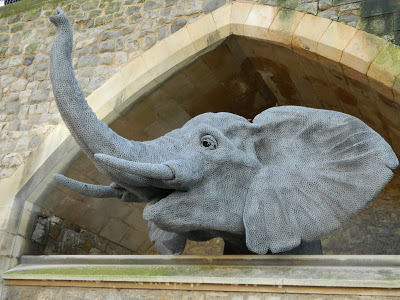 Look closely - can you see the sculpture is made from chicken wire? This blog post was inspired by the wonderful elephant sculpture on display at the Tower of London. I wanted to find out about elephant keeping at the Tower, which it transpires was well-intentioned but misinformed. Read on…
Look closely - can you see the sculpture is made from chicken wire? This blog post was inspired by the wonderful elephant sculpture on display at the Tower of London. I wanted to find out about elephant keeping at the Tower, which it transpires was well-intentioned but misinformed. Read on…A Jumbo-sized Gift
The first elephant at the Tower was a gift from King Louis IX to King Henry III. The animal was a trophy from the crusades in Palestine, but it's quite possible the present was a major headache for Henry. A mandate records, 7 January 1239, orders for the Sheriff of Kent to arrange transport (presumably at his own expense) for the beast.
"…to provide bringing the King's elephant from Whistsand to Dover, and if possible to Londonby water."
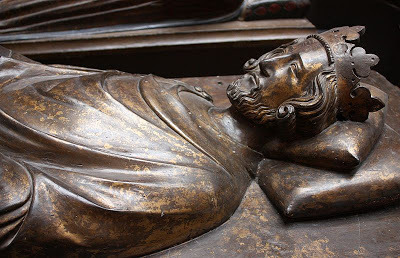 Henry III's tomb
Henry III's tombHousing the Beast
Henry's menagerie at the Tower was started in 1235 with the gift of three leopards as a wedding present from Frederick III, the Holy Roman Emperor. One can only imagine what an awe-inspiring sight his collection must have been, but it seems Henry didn't expect to shoulder the cost himself, but deferred this to the Sheriff of London.
“We command you,” Henry wrote to the Sheriff of London, “that ye cause without delay, to be built at our Tower of London, one house of forty feet long and twenty feet deep, for our elephant.”
Interestingly, the wooden elephant house at 20 by 40 foot was roughly the same dimensions as the recently decommissioned elephant house at London Zoo - only the later housed three, rather than one, elephant!Whilst the kudos of the animals was appreciated by royalty, the expense was not. When James I was gifted an elephant in 1623, from Spain, someone pithily records:
'the Lord Treasurer will be little in love with presents which cost the King as much to maintain as a garrison'
 Ancient and modern: The Tower with the Shard in the background
Ancient and modern: The Tower with the Shard in the backgroundAuthor's own photograph.A Great Draw
In the 13th century few people had ever seen an elephant. Drawings of them were created from descriptions, rather than life, and so ended up looking like horses with long noses. When the elephant arrived at the Tower, such was the draw, that the monk and historian, Matthew Paris, travelled specifically from the abbey at St Albansto study and drawn the animal.
Matthew's drawing is one of the first naturalistic pictures of an elephant. He depicted it with the keeper, Henricus de Flor, in order to show the scale, and described it has having:"Small eyes on top of his head, and eats and drinks with a trunk."
 One of the first naturalistic pictures of an elephant -
One of the first naturalistic pictures of an elephant - By Matthew Paris of Henry III's elephant and his keeper. Keeping Out the Cold
Sadly, for many centuries no one bothered to find out what care the elephants needed to stay healthy. This was typified by James I's elephant, which came with instructions to give it only wine to drink in the winter months, to 'keep out the cold'. The poor animal drank over a gallon of red wine a day, without anyone stopping to query how an elephant would acquire wine in the wild. This elephant didn't live long, but worse still, no lessons were learnt and for another couple of centuries the myth remained and Tower elephants were given wine to drink.
And finally
When Henry III's original elephant died, its grave was near the chapel on Tower Green, close to where Anne Boleyn was later to be buried. However, the bones were later dug up and it is said that 13th century bone and ivory caskets that house reliquaries, (kept at the Victoria and Albert museum) are made from the remains of that elephant.
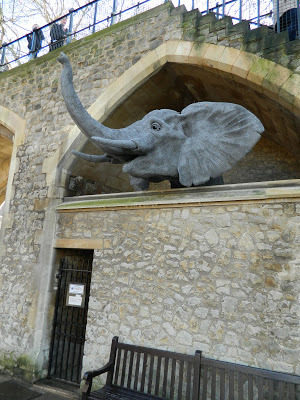
Published on February 13, 2013 03:06
'Familiar Felines.'
Following on from last weeks Halloween posting, today's blog post looks at the unwanted image of cats as the witches familiar - from the Norse Goddess Freya to lonely women in the middle ages.
The full Following on from last weeks Halloween posting, today's blog post looks at the unwanted image of cats as the witches familiar - from the Norse Goddess Freya to lonely women in the middle ages.
The full post can found at:
http://graceelliot-author.blogspot.com
...more
The full Following on from last weeks Halloween posting, today's blog post looks at the unwanted image of cats as the witches familiar - from the Norse Goddess Freya to lonely women in the middle ages.
The full post can found at:
http://graceelliot-author.blogspot.com
...more
- Grace Elliot's profile
- 156 followers



